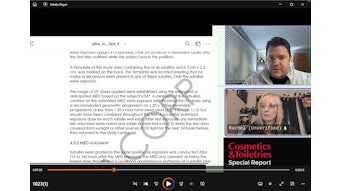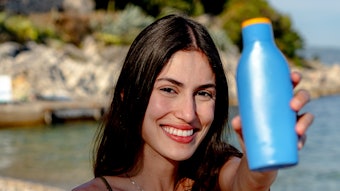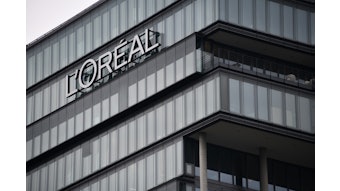The European Commission published a recommendation on the efficacy and claims of sun products on Sept. 22, 2006, which the European Cosmetic, Toiletry and Perfumery Association (Colipa) says it supports.
The commission’s statement details:
“Based on several studies, the International Agency for Research on Cancer of the World Health Organization has emphasized the importance of the link between the correct application of sunscreen products and the efficacy of the sun protection factor claimed. In particular, frequent re-application of sunscreen products is crucial.
“Moreover, in order to reach the protection level indicated by the sun protection factor, sunscreen products have to be applied in quantities similar to the ones used for testing, i.e. 2 mg/cm2, which equals six teaspoons of lotion (approximately 36 g) for the body of one average adult person. This quantity is higher than that usually applied by the consumers. Applying a smaller quantity of sunscreen product leads to a disproportionate reduction in protection. For example, if the quantity applied is reduced by half, protection may fall by as much as two-thirds…
“In order to ensure reproducibility and comparability of the recommended minimum protection against UVB radiation, the International Sun Protection Factor Test Method (2006) as updated in 2006 by the European, Japanese, American and South African industry should be used. In order to assess the minimum protection against UVA radiation, the persistent-pigment darkening method as applied by the Japanese industry and modified by the French health agency Agence française de sécurité sanitaire des produits de santé—Afssaps as well as the critical wavelength test should be used. These testing methods have been submitted to the European Committee for Standardization (CEN) in order to establish European standards in this field…
“Claims concerning the efficacy of sunscreen products should be simple, meaningful and based on identical criteria in order to help the consumer to compare products and to choose the right product for a given exposure and skin type…
“A wide variety of numbers used on labels for indicating the sun protection factor does not support the aim of making claims that are simple and meaningful. The increase in protection from one number to the next is negligible, particularly in the high range. Moreover, the increase in protection is only linear in the case of sunburn, that is to say, a product with sun protection factor 30 protects twice as well from sunburn as product with a sun protection factor of 15. However, a product with sun protection factor 15 absorbs 93% of UVB radiation, and a product with sun protection factor 30 absorbs 97% of UVB radiation.
“Finally, sun protection factors above 50 do not substantially increase the protection from UV radiation. Therefore, the range of labelled sun protection factors can be made smaller without reducing the choice of different strengths for the consumer.”
According to Colipa’s press statement, market research consistently has shown that consumers value the Sun Protection Factor number (SPF) to select their correct level of protection, and continued and consistent use of the SPF designation is in the interest of consumers traveling worldwide.
Colipa agrees that the variety of SPF numbers used on product labels can be limited without significantly reducing choices for consumers. In addition it agrees with the idea that any label referring to UVA protection should be supported by a demonstrated minimum efficacy—and will actively contribute to its implementation.
“The cosmetics industry has a tradition of voluntary initiatives in the field of sun protection testing and labelling, which formed the basis of our collaboration with the European Commission over the last years,” said Bertil Heerink, director-general of Colipa, in a prepared statement. “We will, in cooperation with all stakeholders, continue to contribute to the main objective: to provide consumers with understandable and adequate product information.”
To read the complete recommendation by the European Commission, download the PDF at:
http://eur-lex.europa.eu/LexUriServ/site/en/oj/2006/l_265/l_26520060926en00390043.pdf).










